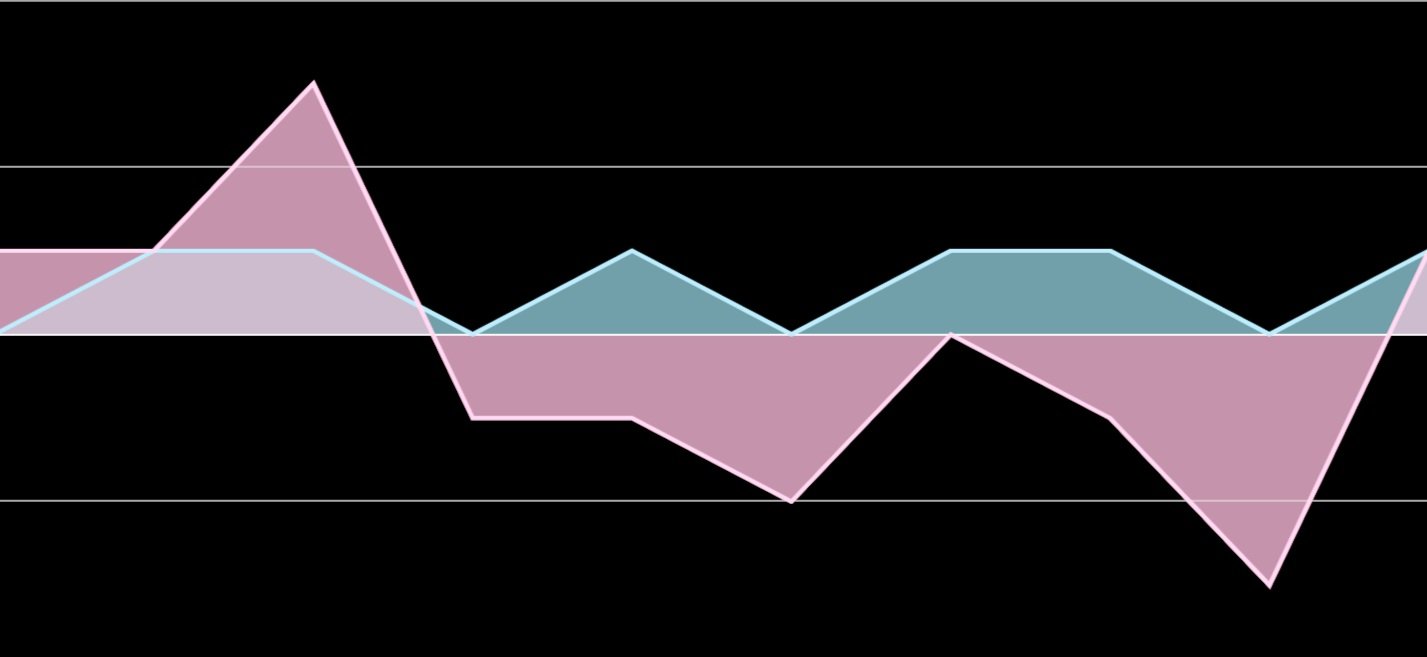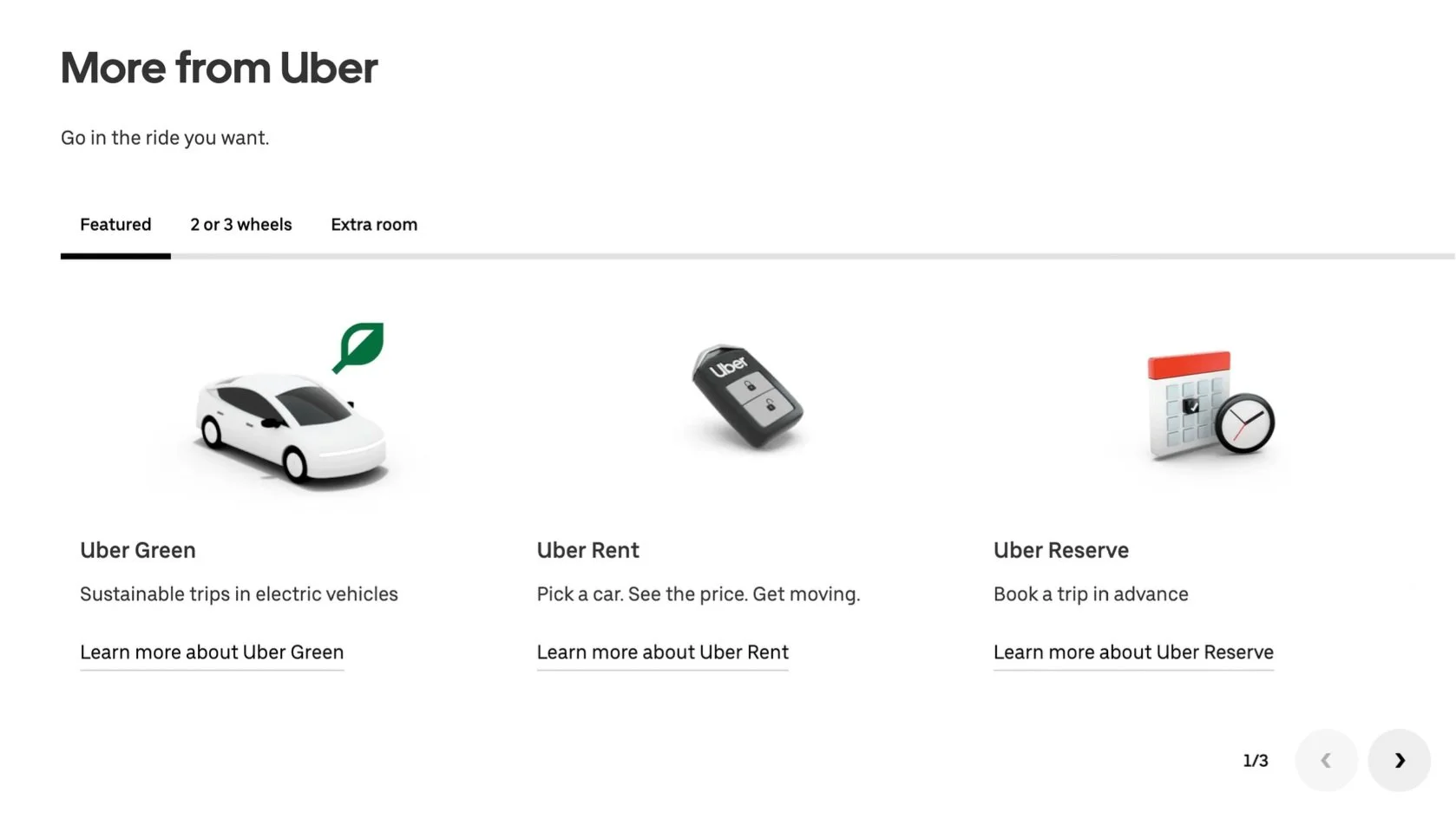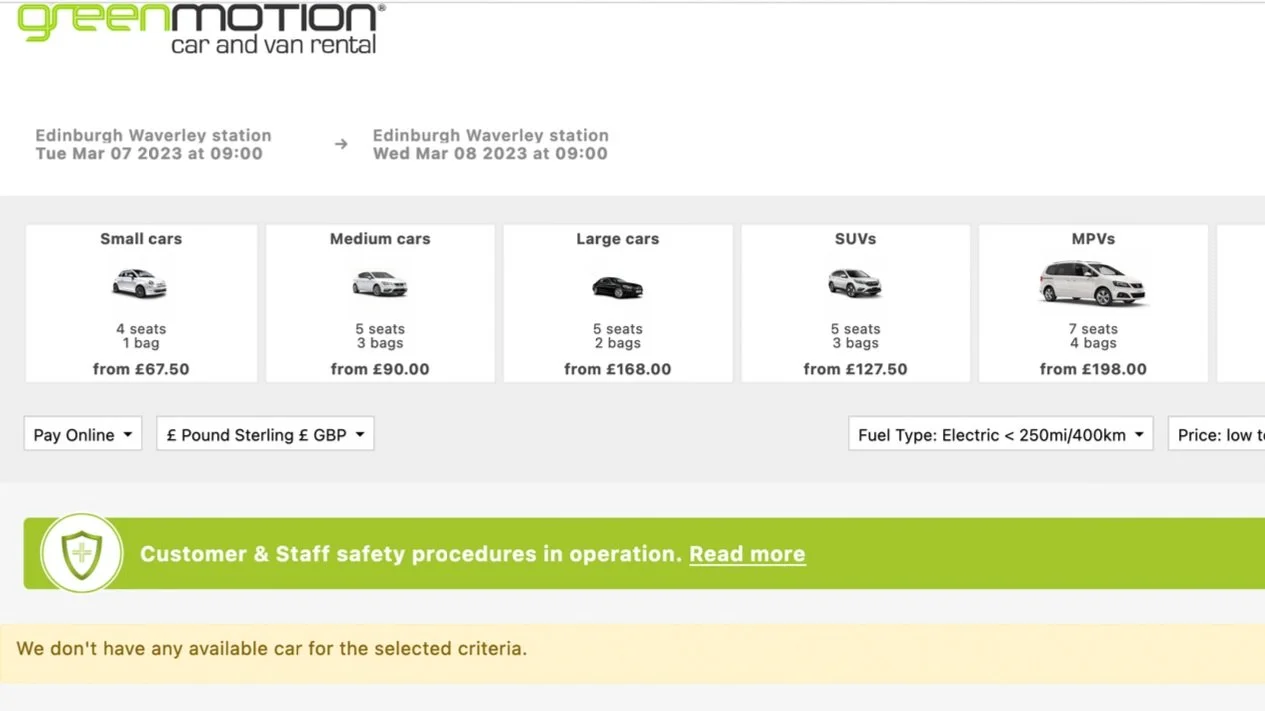We’re Electric
Product Design Case Study

Market Discovery
Market Research - Steps
Competitive Benchmarking
Letting this hypothesis be my guide, I set about choosing competitors to benchmark for their UX, starting with the top-ranking results on Google for ‘electric car hire’ .
I took this approach because an exclusively EV car-hire service would aim to be top-ranking with that search term, and by extension any service that currently appears there would be competing for the searcher’s attention (even if they were not car hire services, which not all were).
Beyond the following services I found for benchmarking, there were a number of other major vendors appearing on the page 1 of that Google search. The major incumbent vendors being the main influence on the mental models of public car-hire service users, I knew I would need to look at these major vendors in the interviews anyway. Therefore I saw the current exercise as a chance to look more broadly at the market, given the findings in the orientation phase.
Services I investigated for benchmarking:
ONTO (EV car leasing)
SIXT (Major international car hire provider)
TURO (Emerging peer-to-peer hiring service)
VOLTAGE HIRE (UK-only EV hire)
+ GREENMOTION (a ‘green’ brand)
++ UBER (ride-sharing)
+ Green Motion was not showing up in the same search but I knew it to be a service that advertised green car hire, so I added this to the list too.
++ I added Uber as a wildcard because of my speculation during the orienation phase. It turns out they were innovating in both green ride-sharing and car hiring, but these services are not mature.
Heuristic Analysis
After noting down the above observations about each service, I scored the services against 10 common UX heuristics with a basic scoring system:
+1 for positive, -1 for negative, 0 for neutral.
I judged Uber to have a far better UX for its purposes than the other services (mainly car hire services) had for theirs.
As well as showing the individual services’ overall scores against these heuristics (see data table below), it was interesting to take the aggregate scores to see which heuristics scored high or low across all services (see area chart below).
As Uber was from another industry and was the leader in UX score, and because I didn't have a new service to compare yet, I used Uber as the comparator for a gap analysis. This gap chart gave me an idea of the heuristics in the sector where there might be competitive advantage if I could improve on them in the UX of the new service.
During this analysis I considered whether I was scoring for my use-case (green car hire), or am I scoring for each service in relation to its own mission, e.g. judging Uber on its own function as a ride-sharing app, as opposed to its ability to provide me with electric options.
I decided it was best to appraise the services predominantly based on their own mission because first and foremost I was appraising the UX of these services. For example, if I scored a service low because it wasn’t letting a user filter by electric vehicles, it might have a great filtering UX in all other ways that could still be applied to a new EV-only service.
While a separate analysis could be useful in future, around how climate-conscious other services were, at this stage making my all-EV car-hire idea more than a consideration in the research would close off possibilities, until a real need for such a service could be demonstrated from a user’s perspective.
Market Analysis
My hypothesis is that hiring via peer-to-peer services such as Turo and Uber will become commonplace.
Sixt is also attempting to more closely resemble the on-demand aspect of Uber ride-sharing but with the customer in the driving seat - the urban car club model.
Onto is looking at attracting the hiring and leasing markets to encourage monthly subscription to the use of a customer's choice of electric car, where they can frequently change the model of car according to their needs or desires.
Hire services seem to have put more attention on web experience design than mobile, whereas rideshare services are mobile-first. The best car-hire services (SIXT/Europcar/Turo) create a seamless experience that draw on the respective strengths of the two device-types.
There is also convergence in terms of service design: Uber’s recently released car-renting UX facilitates their existing connection between users and hire-car providers while Sixt moves toward ride-sharing culture with on-demand short trips, that SIXT indeed refers to as ‘ride-sharing’, where you can drop off the car in many local destinations and are not tied down by return deadlines.
One major finding during the benchmarking process was that, when you filtered only for EVs on major car hire services, there was not much choice of vehicle, and none in some locations. Therefore, achieving a more populated list exclusively of EVs would be an immediate advantage over any major car hire service.
Solution Analysis
My hypothesis is that hiring via peer-to-peer services such as Turo and Uber will become commonplace.
Sixt is also attempting to more closely resemble the on-demand aspect of Uber ride-sharing but with the customer in the driving seat - the urban car club model.
Onto is looking at attracting the hiring and leasing markets to encourage monthly subscription to the use of a customer's choice of electric car, where they can frequently change the model of car according to their needs or desires.
Hire services seem to have put more attention on web experience design than mobile, whereas rideshare services are mobile-first. The best car-hire services (SIXT/Europcar/Turo) create a seamless experience that draw on the respective strengths of the two device-types.
There is also convergence in terms of service design: Uber’s recently released car-renting UX facilitates their existing connection between users and hire-car providers while Sixt moves toward ride-sharing culture with on-demand short trips, that SIXT indeed refers to as ‘ride-sharing’, where you can drop off the car in many local destinations and are not tied down by return deadlines.
One major finding during the benchmarking process was that, when you filtered only for EVs on major car hire services, there was not much choice of vehicle, and none in some locations. Therefore, achieving a more populated list exclusively of EVs would be an immediate advantage over any major car hire service.
An important finding during the benchmarking process was that, when you filtered only for electric cars on major car hire services, there was not much choice of vehicle, and none in some locations.
Competitive Benchmarking
Uber came out as the highest-scoring for UX, and it was also the most unlike a car hire service of the set. So I used Uber as a comparator service in a gap analysis where I compared its scores in each individual heuristic against the aggregate scores of the other services, to see where there might be a gap to improve upon in the new service.
* Uber would also have scored 1 on ‘Match between System and real world’ except that Uber’s EV ride-sharing service was not yet rolled out and it wasn’t clear that it was only a localised service in London.
Heuristic Analysis
After noting down the above observations about each service, I scored the services against 10 common UX heuristics with a basic scoring system.
(+1 for positive, -1 for negative, 0 for neutral)
Picture: Gap Analysis showing Uber, a different product than a car-hire service, scores better overall than the other services listed.
Picture: Note made during synthesis based on the above heuristic gap analysis, drawing a tentative conclusion about the car-hire sector’s overall UX.
Market and Solution analysis
meet a fork in road(map)
It was clear from secondary research and the longer battery ranges now available that we are at a turning point in electric car commerce. Primary research with potential users was now needed to help decide one of two directions for the UX of the new service …
1. At this point in the design cycle, success for a new service looked like an electric car hire service that leans on existing owners of EVs to provide more options to the target market whilst EV ownership is still a minority proportion of all cars. The service could potentially cater to shorter trips. This would favour use of electric vehicles while their range is still relatively limited, allows owners not to be without their cars for long periods, and suits a younger less wealthy demographic who can’t afford cars of their own let alone electric ones, and who may be also priced out of EV options at the incumbent major vendors (a statement based on the fact Turo had more cheap options than car-hire services do).
This would rely on the requirement to market the new service to EV holders in order to generate a supply for customers, and would also represent a more complex UX challenge in becoming a two-sided marketplace app.
2. However, if you were able to solve the supply issue more simply by aggregating the offerings of all major hire platforms for the specific use-case of EV cars, you would also have a simpler UX to build. And any customer looking specifically for electric would have a far more efficient and positive experience of booking an electric car on that new service, because there would be a simpler UX compared with Turo/P2P model, but also a multiple of choices compared with trawling the many individual major services - more of a UX headache only to find fewer options in each.








